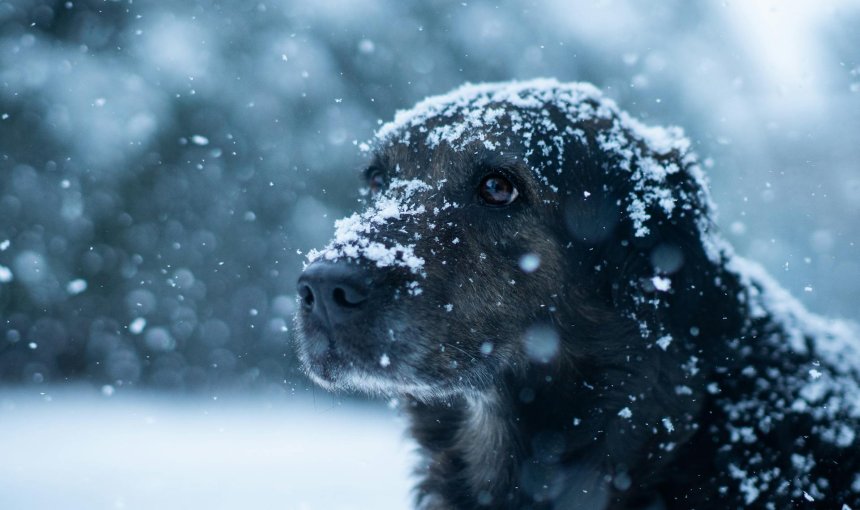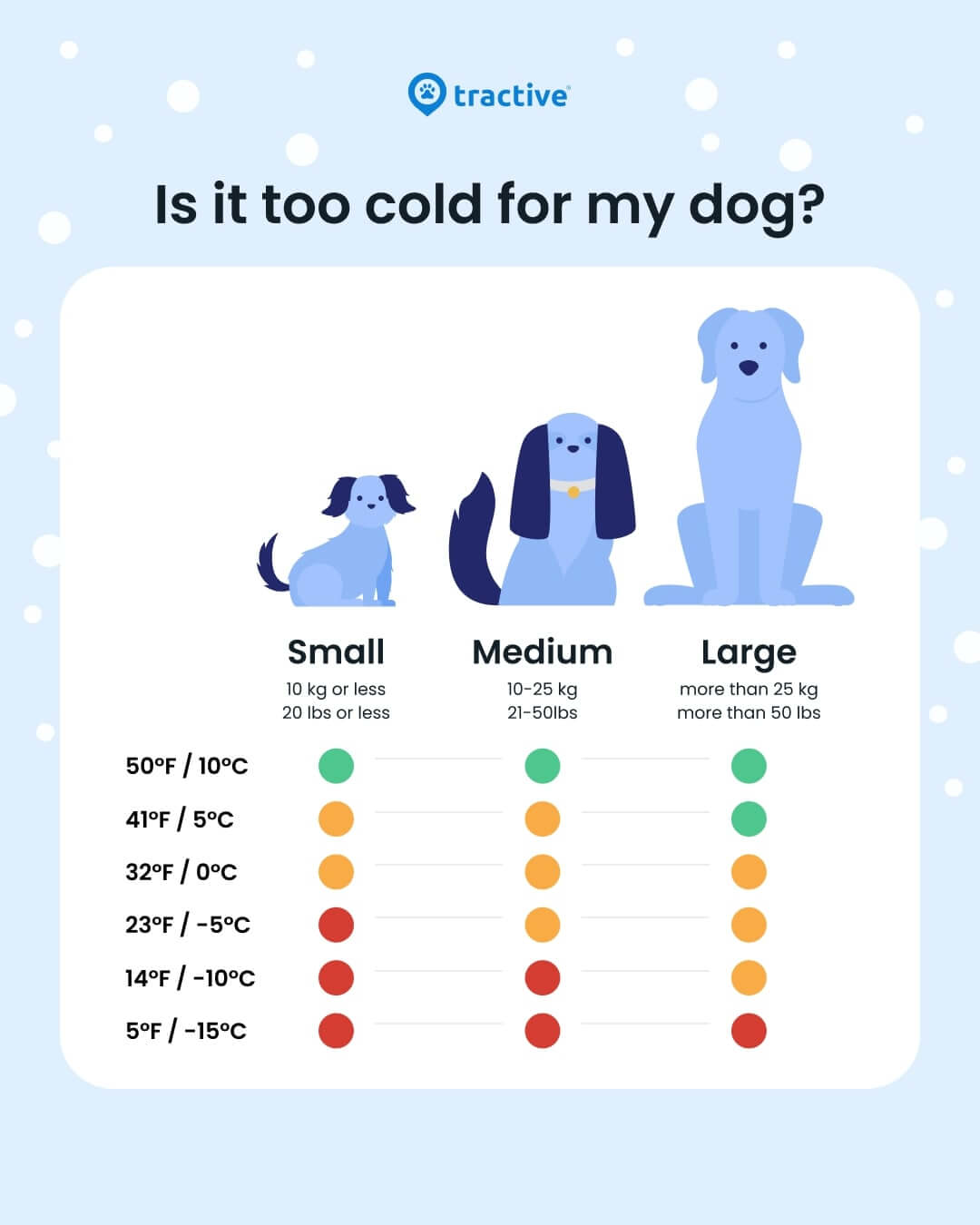Hypothermia In Dogs: Signs, Causes, Prevention & Treatment
Winter brings with it several dangers for our furry friends. Cold weather is one of them. Learn all about the risk of hypothermia in dogs in this post.

As temperatures drop, keeping our canine companions safe becomes even more important. While dogs have fur to help them stay warm, they are still vulnerable to cold weather—especially in extreme conditions. That’s why it’s vital to know how cold is too cold for dogs. One of the most serious risks during colder months is hypothermia, a condition that can lead to severe health complications or even be life-threatening.
In this guide, we’ll explore what hypothermia in dogs is, how to recognize its symptoms, common causes, how to treat it, and most importantly, how to prevent it so your furry friend stays safe and healthy.
Key Takeaways
- Hypothermia is a serious condition that can lead to organ failure or death if not addressed quickly.
- Common symptoms include shivering, lethargy, weakness, pale gums, and low heart rate. Severe cases may involve muscle stiffness, unconsciousness, or coma.
- You can prevent hypothermia by avoiding prolonged exposure to snow, wet ground, and freezing temperatures. Senior dogs, puppies, and small breeds are especially at risk.
- The Tractive GPS & Health Tracker includes vital signs monitoring, helping dog owners detect early signs of hypothermia and take action early.

Always know your buddy is healthy & safe
Read moreWhat is hypothermia in dogs?
Hypothermia occurs when a dog’s internal body temperature drops abnormally low, or below the normal body temperature of 100.1°F to 102.5°F (37.8°C to 39.1°C)1. When the body loses heat faster than it can produce it, the internal temperature drops, impairing normal bodily functions. Severe hypothermia can lead to organ failure, unconsciousness, or even death if not addressed promptly.
Stages of hypothermia in dogs:
- Mild Hypothermia: Body temperature between 90°F and 99°F (32.2-37.2°C). Symptoms are subtle but noticeable.
- Moderate Hypothermia: Body temperature between 82°F and 90°F (27.7-37.2°C). Symptoms worsen, and the dog will need immediate attention.
- Severe Hypothermia: Body temperature below 82°F. This is a life-threatening emergency.
Signs of hypothermia in dogs
Recognizing the symptoms of hypothermia is crucial for taking swift action. Signs include:
- Shivering: This is often the first sign as the body attempts to generate heat.
- Lethargy and Weakness: A drop in energy, sluggish movement, or unresponsiveness.
- Cold Extremities: Ears, paws, limbs and tail may feel cold to the touch.
- Pale or Blue Gums: Indicating poor blood circulation.
- Slow Breathing or Heart Rate: The body begins to slow its functions to conserve energy.
- Dilated Pupils: A sign that the condition is worsening.
- Stumbling or Confusion: Similar to disorientation in humans.
- Collapse or Unconsciousness: This occurs in severe cases.
If your dog is exhibiting any of these symptoms, especially in combination, it’s critical to act quickly.

Get health alerts for your dog
Our pups can’t always tell us if something’s wrong. But if their tracker detects unusual changes in their routine, you’ll get an alert, helping you catch potential issues early.
Common causes of hypothermia in dogs
Dogs can develop hypothermia from various situations, including:
- Cold Weather Exposure: Extended time outdoors in freezing temperatures without protection.
- Wet Fur: Wet fur accelerates heat loss, making a dog cold much faster.
- Wind Chill: Strong winds strip away body heat more quickly, increasing the risk.
- Submersion in Cold Water: Falling into icy lakes, rivers, or ponds can rapidly cause hypothermia.
- Age and Health Factors: Puppies, senior dogs, and those with health issues or thin coats are more susceptible.
- Small or Thin Breeds: Dogs with little body fat or fur, like Greyhounds or Chihuahuas, are at higher risk.
- Inactivity: Dogs that remain still for long periods in the cold are more vulnerable.
Immediate steps to take if your dog has hypothermia
If you suspect your dog is suffering from hypothermia, quick action is vital. Here’s what you should do:
- Move Your Dog Indoors: Bring your dog to a warm, sheltered space immediately.
- Wrap Them in Blankets: Use dry, warm blankets or towels. You can also warm the blanket beforehand in a dryer.
- Use Body Heat: Cuddle with your dog to transfer warmth.
- Apply Gentle Heat: Use a heating pad or hot water bottle wrapped in a towel. Never place direct heat on your dog, as it could cause burns.
- Check Their Temperature: If you have a pet thermometer, monitor your dog’s body temperature.
- Offer Warm Fluids: If your dog is alert, offer lukewarm water or a vet-approved broth to help warm them internally.
- Visit the Vet Immediately: Even if your dog appears to be recovering, a veterinarian must evaluate them to rule out internal damage.
What NOT to do:
- Do not use hair dryers or heating lamps—these can cause burns or worsen the situation.
- Do not immerse your dog in hot water; this can shock their system.
- Do not assume mild symptoms will go away on their own. Hypothermia can escalate quickly.
How vets treat hypothermia
When you take your dog to the veterinarian, they will:
- Stabilize Body Temperature: Using heating pads, thermal blankets, or warm IV fluids.
- Monitor Vital Signs: Checking heart rate, breathing, and blood pressure.
- Administer Oxygen: If breathing is compromised.
- Address Underlying Issues: Hypothermia may have other complications, such as frostbite or organ damage.
The sooner your dog receives professional treatment, the better their chances for a full recovery.
Preventing hypothermia in dogs
The best way to protect your dog from hypothermia is through prevention. Here are steps to keep your dog warm and safe:
- Limit Outdoor Exposure: Avoid long walks or playtime in freezing temperatures. Keep outings short and frequent.
- Dress Your Dog Appropriately: Use insulated dog jackets or sweaters, especially for small, senior, or short-haired dogs.
- Protect Paws: Use dog booties to shield paws from snow, ice, and freezing surfaces.
- Dry Your Dog Thoroughly: After exposure to rain or snow, dry your dog’s fur completely to prevent rapid heat loss.
- Provide a Warm Shelter: For outdoor dogs, ensure they have a dry, insulated, and windproof shelter with blankets or straw for warmth.
- Avoid Cold Water: Keep your dog away from frozen lakes, ponds, or rivers where they might fall through thin ice.
- Monitor Weak or Vulnerable Dogs: Puppies, elderly dogs, or sick dogs need closer monitoring during colder months.
- Use GPS Trackers for Safety: If your dog spends time outdoors, a GPS dog tracker can help locate them quickly if they get lost or stranded in the cold. The Tractive GPS also includes Health Monitoring that keeps track of your dog’s vital signs – including their heart rate. So you can catch on to the signs of hypothermia quicker.
Read More: Winter Dog Care: Protect Your Dog This Winter With These 8 Tips
How cold is too cold for dogs?
A general guideline for temperature safety is:
- Above 45°F (7°C): Most dogs are comfortable, though small or thin-coated dogs may start to feel chilly.
- Below 32°F (0°C): Small, short-haired, or very young/old dogs are at risk. Use protection.
- Below 20°F (-6°C): All dogs are at risk for hypothermia and frostbite, even with fur and insulation.
Keep in mind that wind chill and wet conditions can make these temperatures feel much colder.

Frostbite vs. hypothermia
Hypothermia and frostbite often go hand in hand in cold weather. Frostbite occurs when tissues freeze, typically affecting the ears, tail, and paws. It’s important to watch for signs like pale, cold, or discolored skin. If you suspect frostbite, follow similar warming steps as with hypothermia and consult your veterinarian immediately.
Read More: How To Protect Dog Paws In Winter & Snow
Final thoughts
Hypothermia is a serious but preventable condition. By recognizing the early signs, taking prompt action, and using proactive measures to protect your dog from the cold, you can ensure they stay safe and warm throughout winter. Whether it’s bundling up in a cozy jacket, avoiding prolonged exposure to freezing temperatures, or using a GPS tracker for peace of mind, every effort counts.
Remember: If you suspect hypothermia, don’t wait—act fast and seek veterinary care. Your dog’s health and safety are worth it!
Stay warm, stay vigilant, and enjoy a safe winter with your furry best friend.




